

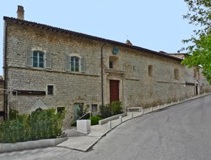
A community of Benedictine nuns from Santa Caterina di Picaiai (which was named for a hill outside Porta Nuova on the road to Viole) was first documented in 1259. It moved to this site outside the Roman walls in ca. 1278. This site was included within the new circuit of walls that was begun in 1361.
The nuns’ behaviour began to cause scandal in 1501 when they were evicted for a period. Some were expelled again in 1521. The community was suppressed in 1529. The complex passed to a community of Cistercian nuns from Santa Giustina, Perugia in 1546, but they were evicted because they failed to observe strict clausura. The nuns from Assisi returned but the community was suppressed, this time definitively, in 1595.
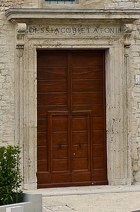
The complex has been restored and now houses a hotel and restaurant, Relais Nun. The nuns’ church, now known as Sala Santa Caterina, is used for functions.
Roman Amphitheatre (1st century AD)
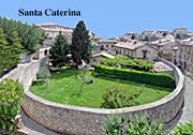
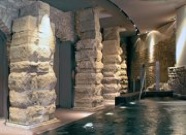
Part of the ex-nunnery is built on the foundations of an elliptical wall of the south-eastern part of the Roman amphitheatre.
Excavations in 2007 brought to light the remains of seven pilasters in the lower part of the facade; five are still standing but two seem to have collapsed during an earthquake. The excavations have also unearthed part of the outer corridor and other remains. This area now houses the hotel spa.
Art from the Complex
Frescoes (14th century)
A number of detached frescoes from the church are now in the Pinacoteca Comunale. These include:

-
✴a fragment depicting three men with knives from a much larger fresco; and

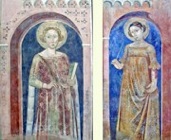
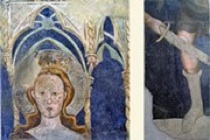
-
✴other, slightly later frescoes that are attributed to a follower of Pace di Bartolo:
-
•a fragment from the martyrdom of St Stephen;
-
•figures of St Catherine of Alexandria and another female saints; and
-
•other fragments, including the head of a femele saint and the leg of a soldier illustrated above.
Frescoes (date)
These frescoes are in the the Szépművészeti Múzeum (Museum of Fine Arts, Budapest). [Describe]
Ildikó Fehér, “Frescoes from the Ospedale di S. Caterina, Assisi in the Collection of the Budapest Museum of Fine Arts”, Arte Cristiana, 95 (July-August) (2007) 241-50
Martyrdom of St Catherine (1608)
This panel from Santa Caterina is the earliest known work that is signed by Cesare Sermei and dated. He described himself as “Urbevetani” (from Orvieto) because he painted the panel before he became a citizen of Assisi (in 1611). [Where is it now??]
Gonfalon (1626-7)
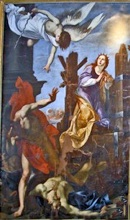

This double-sided processional banner, belonged to the Confraternita di SS Giacomo e Antonio and came from the church, is now now in the Museo Diocesano:
-
✴One side depicts the martyrdom of St Catherine of Alexandria.
-
✴The other side depicts SS James and Antony Abbot.
The Pisan artist Orazio Riminaldi was said to have painted a standard depicting SS James and Philip (sic) in an account of his work written in 1787. This standard was believed to have been lost until 1978, when it was suggested that this was the work in question. The attribution is sustained on stylistic grounds and also by a documented association of the artist and Bishop Marcello Crecenzi of Assisi in 1628. Payments are recorded for this standard in 1626-7 to the otherwise unknown Giovanni Battista Muzico. He was presumably the agent of Orazio Riminaldi, which suggests that the banner was painted in Rome.
Return to Oratories of Assisi.
Return to Nunneries of Assisi.
Return to Monuments of Assisi.
Return to Walk I.
Return to the home page on Assisi.

